Those of you who know me, know that one of the few things I love more than machetes are axes; especially tomahawks and similar sized hatchets. I’m also slightly OCD and enjoy building data bases. So here goes, definitions, a little history, some large axes and some small axes and what their functionality is…aside from just chopping. The caveat is that these are generalizations and don’t take into account the dozens of specialized carpentry and wood working tools, nor do they represent the cultural diversity throughout the world. As usual, primary references are listed below.
The Axe
The axe has two primary components: the axe head, and the haft.
The axe head is typically bounded by the bit (or blade) at one end, and the poll (or butt) at the other, though some designs feature two bits opposite each other. The top corner of the bit where the cutting edge begins is called the toe, and the bottom corner is known as the heel. Either side of the head is called the cheek, which is sometimes supplemented by lugs where the head meets the haft, and the hole where the haft is mounted is called the eye. The part of the bit that descends below the rest of the axe-head is called the beard, and a bearded axe is an antiquated axe head with an exaggerated beard that can sometimes extend the cutting edge twice the height of the rest of the head.
The axe haft is sometimes called the handle. Traditionally, it was made of a resilient hardwood like hickory or ash, but modern axes often have hafts made of durable synthetic materials. Antique axes and their modern reproductions, like the tomahawk, often had a simple, straight haft with a circular cross-section that wedged onto the axe-head without the aid of wedges or pins. Modern hafts are curved for better grip and to aid in the swinging motion, and are mounted securely to the head. The shoulder is where the head mounts onto the haft, and this is either a long oval or rectangular cross-section of the haft that’s secured to the axe head with small metal or wooden wedges. The belly of the haft is the longest part, where it bows in gently, and the throat is where it curves sharply down to the short grip, just before the end of the haft, which is known as the knob.
The History
Initially axes were tools of stone called hand axes, used without handles (hafts), and had knapped (chipped) cutting edges of flint or other stone. Axes made with ground cutting edges are known since the Neolithic period ending 4,000 to 2,000 BC. The first true hafted axes are known from the Mesolithic period (ca. 6000 BC). Few wooden hafts have been found from this period, but it seems that the axe was normally hafted by wedging. Birch-tar and raw-hide lashings were used to fix the blade. Stone axes are still produced and in use today in parts of Irian Jaya, New Guinea. The Mount Hagen area was an important production center.
From the late Neolithic/Chalcolithic onwards, axes were made of copper or copper mixed with arsenic. These axes were flat and hafted much like their stone predecessors. Axes continued to be made in this manner with the introduction of Bronze metallurgy. Eventually the hafting method changed and the flat axe developed into the ‘flanged axe,’ then palstaves, and later winged and socketed axes.
Most modern axes have steel heads and wooden handles, typically hickory in the US and ash in Europe, although plastic or fiberglass handles are also common. Modern axes are specialized by use, size and form. Hafted axes with short handles designed for use with one hand are often called hand axes but the term hand axe refers to axes without handles as well. Hatchets tend to be small hafted axes often with a hammer on the back side (the poll). As easy-to-make weapons, axes have frequently been used in combat.
Axes designed to cut or shape wood
Felling axe: Cuts across the grain of wood, as in the felling of trees. In single or double bit (the bit is the cutting edge of the head) forms and many different weights, shapes, handle types and cutting geometries to match the characteristics of the material being cut. More so than with for instance a splitting axe, the bit of a felling axe needs to be very sharp, to be able to efficiently cut the fibres.
Splitting axe: Used in wood splitting to split with the grain of the wood. Splitting axe bits are more wedge shaped. This shape causes the axe to rend the fibers of the wood apart, without having to cut through them.
Broad axe: Used with the grain of the wood in precision splitting or “hewing” (i.e. the squaring-off of round timbers usually for use in construction). Broad axe bits are most commonly chisel-shaped (i.e. one flat and one beveled edge) facilitating more controlled work as the flat cheek passes across the squared timber.
Adze: A variation featuring a head perpendicular to that of an axe. Rather than splitting wood side-by-side, it is used to rip a level surface into a horizontal piece of wood. It can also be used as a pickaxe for breaking up rocks and clay.
Hatchet: A small, light axe designed for use in one hand specifically while camping or travelling. A hatchet should not to be confused with a hand axe, which is a small axe meant to be used with one hand. Technically, a hatchet has a hammer head on the back side. A hand axe, like a normal axe, has a broad flat area on the back side.
Carpenter’s axe: A small axe, usually slightly larger than a hatchet, used in traditional woodwork, joinery and log-building. It has a pronounced beard and finger notch to allow a “choked” grip for precise control. The poll is designed for use as a hammer.
Hand axe: A small axe used for intermediate chopping, similar to hatchets.
Mortising Axe: Used for creating mortises, a process which begins by drilling two holes at the ends of the intended mortise. Then the wood between the holes is removed with the mortising axe. Some forms of the tool have one blade, which may be pushed, swung or struck with a mallet. Others, such as twybil, bisaigüe and piochon have two, one of which is used for separating the fibres, and the other for levering out the waste.
Axes as weapons
Battle axe: In its most common form, an arm-length weapon borne in one or both hands. Compared to a sword swing, it delivers more cleaving power against a smaller target area, making it more effective against armor, due to concentrating more of its weight in the axehead. There are quite literally thousands of variations of battle axes through out the world and over various time periods.
Tomahawk: used almost exclusively by Native Americans, its blade was originally crafted of stone. Along with the familiar war version, which could be fashioned as a throwing weapon, the pipe tomahawk was a ceremonial and diplomatic tool.
Spontoon Tomahawk: A French trapper and Iroquois collaboration, this was an axe with a knife-like stabbing blade instead of the familiar wedged shape.
Shepherd’s axe: used by shepherds in the Carpathian Mountains, it could double as a walking stick.
Ono: a Japanese weapon wielded by sōhei warrior monks.
Dagger-axe (Ji or Ge): A variant of Chinese spearlike weapon with a divided two-part head, consisting of the usual straight blade and a scythe-like blade. The straight blade is used to stab or feint, then the foe’s body or head may be cut by pulling the scythe-like horizontal blade backwards. Ge has the horizontal blade but does not have the straight spear.
Halberd: a spearlike weapon with a hooked poll, effective against mounted cavalry.
Pollaxe: designed to defeat plate armour. Its axe (or hammer) head is much narrower than other axes, which accounts for its penetrating power.
Danish axe: A long-handled weapon with a large flat blade, often attributed to the Vikings.
Throwing axe: Any of a number of ranged weapons designed to strike with a similar splitting action as their melee counterparts. These are often small in profile and usable with one hand.
Hurlbat: An entirely metal throwing axe sharpened on every auxiliary end to a point or blade, practically guaranteeing some form of damage against its target.
Francisca or Frankish axe: a short throwing weapon of the European Migration Period, the name of which may have become attached to the Germanic tribe associated with it: the Franks (see France).
Parashu: The parashu (Sanskrit: paraṣu) is an Indian battle-axe. It is generally wielded with two hands but could also be used with only one. It is considered as the primary weapon of Parashurama, the 6th Avatar of Lord Vishnu in Hinduism.
Sagaris: An ancient weapon used by Scythians.
Axes as tools
Double bit axe: A common axe in the ancient world; introduced to America in the 1800s. The heavy head makes it ideal for felling trees. Often one bit is designated for tasks that would more quickly dull the edge such as cutting roots through dirt.
Firefighter’s axe, fire axe, or pick head axe: It has a pick-shaped pointed poll (area of the head opposite the cutting edge). It is often decorated in vivid colors to make it easily visible during an emergency. Its primary use is for breaking down doors and windows.
Ice axe or climbing axe: A number of different styles of ice axes are designed for ice climbing and enlarging steps used by climbers.
Lathe hammer (also known as a lath hammer, lathing hammer, or lathing hatchet): a tool used for cutting and nailing wood lath which has a small hatchet blade on one side (which features a small lateral nick used for pulling out nails) and a hammer head on the other.
Mattock: A dual-purpose axe, combining an adze and axe blade, or sometimes a pick and adze blade.
Pickaxe: An axe with a large pointed end, rather than a flat blade. Sometimes exists as a double-bladed tool with a pick on one side and an axe or adze head on the other. Often used to break up hard material, such as rocks or concrete.
Pulaski: An axe with a mattock blade built into the rear of the main axe blade, used for digging (‘grubbing out’) through and around roots as well as chopping. In addition to the McLeod (a tool similar to a hoe/rake combination), the pulaski is an indispensable tool used in fighting forest fires, as well as trail-building, brush clearance and similar functions.
Slater’s axe: An axe for cutting roofing slate, with a long point on the poll for punching nail holes, and with the blade offset laterally from the handle to protect the worker’s hand from flying slate chips.
Splitting maul: A splitting implement that has evolved from the simple “wedge” design to more complex designs. Some mauls have a conical “axehead”; compound mauls have swiveling “sub-wedges”, among other types; others have a heavy wedge-shaped head, with a sledgehammer face opposite.
http://en.wikipedia.org/wiki/Axe

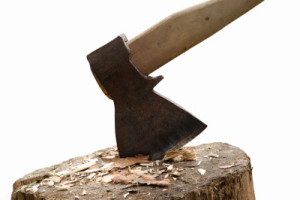
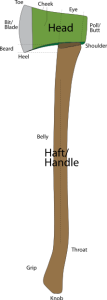
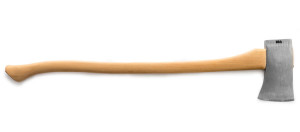
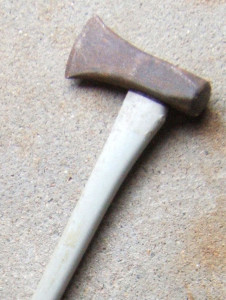
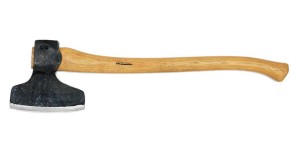

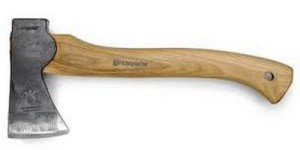
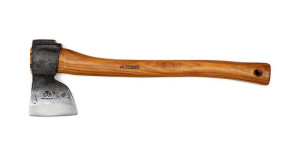
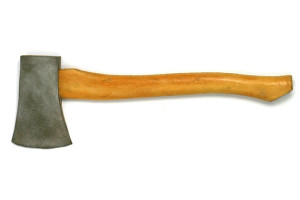
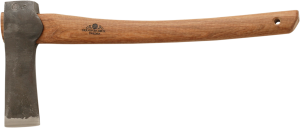

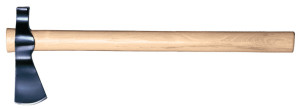

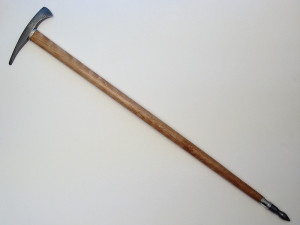
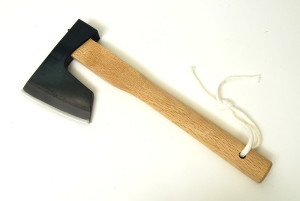
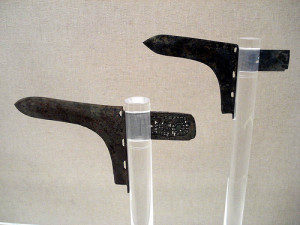
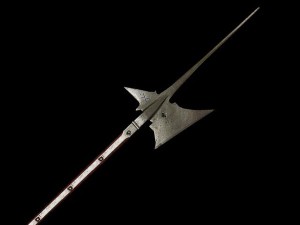
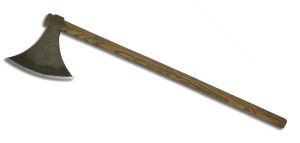
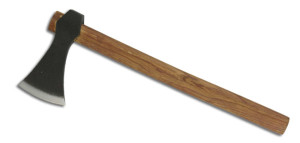
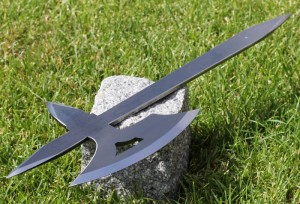
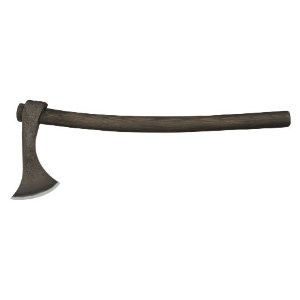
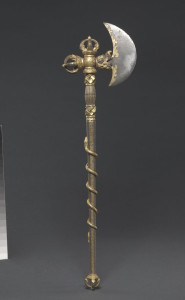
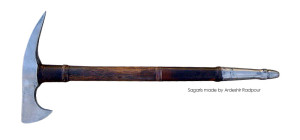

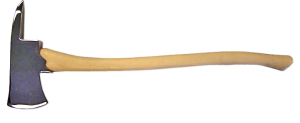
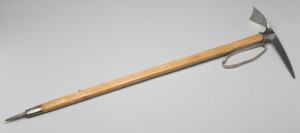
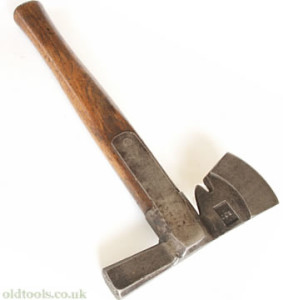
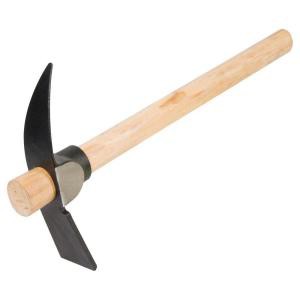
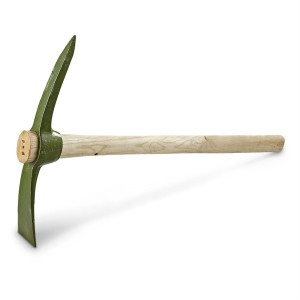
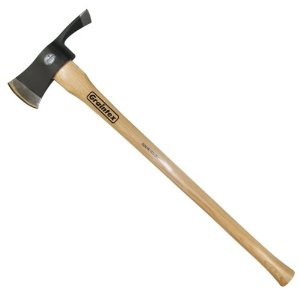
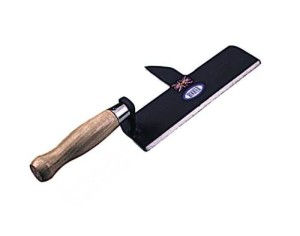
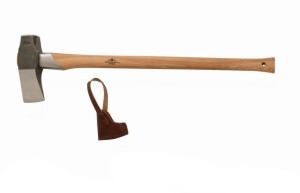
Leave a Reply